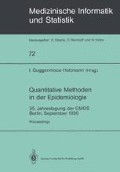Zusammenfassung
Therapieentscheidungen bei Patienten mit akutem Brustschmerz sind kritisch und mit Risiken behaftet. Dies gilt insbesondere für die Frage nach einer notwendigen Aufnahme in die Intensivstation oder für die mögliche Entlassung daraus. In neuerer Zeit wurden klinische Studien durchgeführt, in denen solche Patienten spezifischen Gruppen zugeordnet und daraufhin die Krankheitsverläufe beobachtet wurden. Die Beobachtungen erstreckten sich auf Komplikationen, Diagnosen oder Mortalität. Diese Ergebnisse aus den Studien sind in der konkreten Entscheidungssituation nur bedingt verfügbar. Die Heterogenität der Studien im Hinblick auf deren Fragestellung, Patientenkollektive, Entscheidungsparameter sowie beobachtete Ereignisse ist ein Grund dafür. Ziel unseres Ansatzes ist, entscheidungsrelevantes Literaturwissen in einer Wissensbasis zu repräsentieren und über einen Konsultationsrahmen effizient verfügbar zu machen. Es soll im Dialog mit dem System möglich sein, anhand von Symptomen und Befunden die in Betracht kommenden Studien zu selektieren, die Patienten spezifischen Gruppen zuzuordnen und die Gruppenergebnisse aus den Studien darzustellen.
Access this chapter
Tax calculation will be finalised at checkout
Purchases are for personal use only
Preview
Unable to display preview. Download preview PDF.
Literatur
Christaller T. DlPrimio F. Voss A (Hrsg.): Die KI-Werkbank Babylon: Eine offene und portable Entwicklungsumgebung für Expertensysteme. Addison-Wesley, 1989: Bonn.
Lee TH. Cook EF, Weisberg M. Sargent RK, Wilson C. Goldman L: Acute Chest Pain in the Emergency Room: Identification and Examination of Low-Risk Patients. Arch Intern Med 1985; 145: 65–69.
Goldman L, Cook EF, Brand DA et al: A computer protocol to predict myocardial infarction In emergency department patients with chest pain. N Engl J Med 1988; 318: 797–803.
Fuchs R, Scheidt S: Improved Criteria for Admission to Cardiac Care Units. JAMA 1981; 246: 2037–2041.
Zalenskl RJ, Sloan EP, Chen EH et al: The Emergency Department ECG and Immediately Life-Threatening Complications in Initially Uncomplicated Suspected Myocardial Infarction; Ann Emerg Med 1988; 17: 22 1226.
Yusuf S. Pearson M. Sterry H et al: The entry ECG in the early diagnosis and prognostic stratification of patients with suspected acute myocardial infarction. Eur Heart J 1984; 5: 690–696.
Tierney WM, Roth BJ, Psaty B et al: Predictors of myocardial infarction In emergency room patients. Crit Care Med 1985; 13: 526–531.
Brush JE, Brand DA, Acampora D, Chafiner B, Wackers FJ: Use of the initial electrocardiogram to predict in-hospital complications of acute myocardial infarction. N Engl J Med 1985; 312: 1137–1141.
Stark ME. VacekJL: The Initial Electrocardiogram During Admission for Myocardial Infarction. Arch Intern Med 1987; 147: 843–846.
Pozen MW. D’Agostino RB. Selker HP et al: A predictive instrument to improve coronary-care-unit admission practices in acute ischemic heart disease: A Prospective Multicenter Clinical Trial. N Engl J Med 1984; 310: 1273–1278.
Nattel S, Warnica JW, Ogilvie RI: Indications for admission to a coronary care unit in patients with unstable angina. Can Med Assoc J 1980; 122: 180–184.
Battler A, Karliner JS, Higgins CB et al: The initial Chest X-ray In Acute Myocardial Infarction: Prediction of Early and Late Mortality and Survival. Circulation 1980; 61: 1004–1009.
Quale J. Kimmelstiel C. Llpschlk G, Schrem S: Use of Sequential Cardiac Enzyme Analysis in Stratification of Risk for Myocardial Infarction in Patients With Unstable Angina. Arch Intern Med 1988; 148: 1277 1279.
Plérard LA. Dubois C, Albert A. Chapelle J-P. Carder J, Kulbertus HE: Prognostic Significance of a Low Peak Serum Creatinine Kinase Level in Acute Myocardial Infarction: Am J Cardiol 1989; 63: 792–796.
Baker P: Chest pain and time taken for diagnosis in myocardial infarction. Br J Clin Pract 1987; 41: 779781.
Lee TH, Rouan GW, Weisberg MC et al: Sensitivity of Routine Clinical Criteria for Diagnosing Myocardial Infarction Within 24 Hours of Hospitalization. Ann Intern Med 1987; 106: 181–186.
Mulley AG. Thibault GE, Hughes RA, Barnett GO. Reder VA. Sherman EL: The course of patients with suspected myocardial infarction: The identification of Low-Risk Patients for Early Transfer for Intensive Care. N Engl J Med 1980; 302: 943–948.
Bosch X. Théroux P. Waters DD. Pelletier GB. Roy D: Early postinfarction ischemia: clinical, angiographie, and prognostic significance. Circulation 1987; 75: 988–995.
Schuster H-P, Assel RJ, Weilemann LS: Aussagekraft des “Therapeutic Intervention Scoring System” (TISS) bel kritisch Kranken in einer internen Intenslvstation. Med Klinik 1986; 81: 117–121.
Schrlger DL, BaraffLJ. Wilton R. McCoy JM: EDECS: The Emergency Department Expert Charting System. In: Kingsland LC (Hrsg.): Proc. 13th Symposium on Computer Applications in Medical Care, Seiten 611615; IEEE Computer Society Press, 1989: Washington DC.
Rennels GD: A Computational Model of Reasoning from the Clinical Literature Lecture Notes in Medical Informatics 32; Springer, 1987: Berlin. Heidelberg, New York.
Author information
Authors and Affiliations
Editor information
Editors and Affiliations
Rights and permissions
Copyright information
© 1991 Springer-Verlag Berlin Heidelberg
About this paper
Cite this paper
Roessink, B., Bernauer, J., Schuster, HP. (1991). Entscheidungsunterstützung durch Literaturwissen bei akutem Brustschmerz. In: Guggenmoos-Holzmann, I. (eds) Quantitative Methoden in der Epidemiologie. Medizinische Informatik und Statistik, vol 72. Springer, Berlin, Heidelberg. https://doi.org/10.1007/978-3-662-00879-9_63
Download citation
DOI: https://doi.org/10.1007/978-3-662-00879-9_63
Publisher Name: Springer, Berlin, Heidelberg
Print ISBN: 978-3-540-53793-9
Online ISBN: 978-3-662-00879-9
eBook Packages: Springer Book Archive

